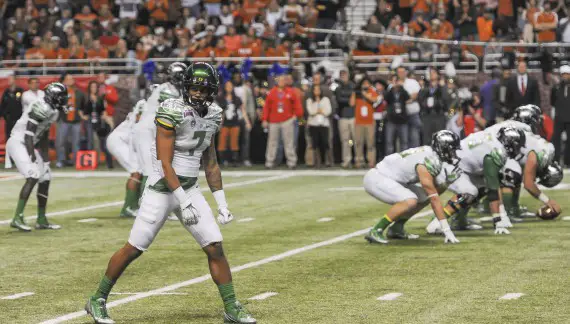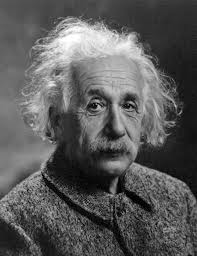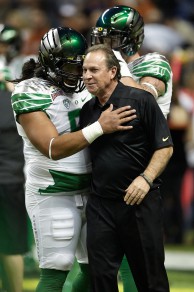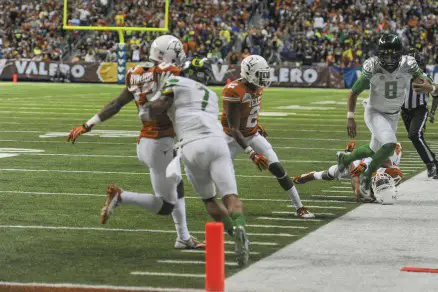In a June 27 analysis, ESPN’s Ted Miller rated Oregon’s receivers as “We’ll see.” Ted awarded “Great shape” to receivers for Stanford, Arizona, WSU, USC, ASU and the Berkeley Bears. UCLA, Utah, Washington, OSU and even Colorado got “Good shape.” That left only Oregon to receive the dreaded “We’ll see.”
Einstein and I disagree. Just as the theory of special relativity requires that you look at space and time as a single continuum known as space-time, to look at the Oregon receiving corps without considering how they relate to the overall offensive structure, not to mention the speed of light, can result in conclusions that don’t hold up under close scrutiny.
First, just as there is no gravity without warps in the space-time continuum, there are no receivers without a quarterback, and Oregon has the best. Those teams that are in “great shape” had 75 of their passes intercepted last year (12.5 per team). Oregon’s Marcus Mariota had four. WSU’s Connor Halliday, who probably caused some disturbances to the time-space continuum with the number of passes he threw against the Ducks last year (At least I felt that way by the time the game was finalllllllllly over.), had 22 interceptions. And I also wonder if he maybe didn’t break the Pac-12 record for most incomplete passes, along with the other records he broke against the Ducks. But I digress. Mariota will bring out the best in Oregon’s receivers — absolutely, nothing relative about it.
Second, there’s the coaching. Matt Lubick was the 2012 Wide Receivers Coach of the Year, so you have to know that Oregon’s relatively young receiver corps will receive the best coaching possible.
The receivers also have to be considered relative to the offensive line. Oregon returns five talented starters who have been hitting the weight room hard, and in Steve Greatwood the Ducks have possibly the best offensive line coach in the country. Chances are Mariota is going to have a relatively long time to find open receivers.
Then there are the other pass-catching threats. The Ducks are relatively loaded at tight end, and any team that devotes too much matter and energy to watching the receivers won’t have a quantum of a chance against Thomas Tyner’s 10.3 hundred speed when he explodes out of the backfield on a wheel route.
Most of all, though, you have to consider the receivers in relation to Oregon’s running game. In addition to catching passes, Duck receivers are expected (and trained) to block for the run, which is a statistic that never shows up in the post-game analysis. And when you consider that defenses have to contend with Byron Marshall, Thomas Tyner and Mariota running the ball, not to mention probably an occasional sweep by Devon Allen, the defensive backs are going to be relatively short-handed covering the Duck receivers.
It’s well known that the Ducks like to stretch the field sideline to sideline, but they have a new wrinkle to the continuum with the addition of wide receiver Allen, who just this Sunday became the first speedster to double NCAA and USATF 110 meter hurdles titles since the great Renaldo Nehemiah did it in 1979. And Allen did it by beating professionals and Olympians in the process. But here’s the relatively bad news for those eleven Pac-12 teams who appear to have better receivers relative to Oregon: As a freshman, Allen is relatively young, so he’s due to be on the roster for a relatively long time. He’s so young that he would have to time travel back to sixteen years before he was even born to see Nehemiah pull his double.
So the Oregon receivers have all kinds of relative advantages: A great quarterback to get them the ball, great coaching, a talented and experienced offensive line, a dynamite running game, passing options with backs and tight ends to divert coverage, and a deep threat who runs relatively closer to the speed of light than anyone on the field. This creates a relative dilemma for defensive backs. If they don’t load the box, look out for the running game. Flush the quarterback and risk a twenty yard (or more) scamper behind receivers who are trained to block. Play the receivers loose and leave them open for pinpoint passing. Play a two-time national sprint champion tight? Bad idea. Double-team him – one short, one long – and you’ve got one less man to watch the run. Drop into zone? Here comes the run again … Einstein and I are relatively glad we’re not defensive coordinators.
Ted Miller says, “We’ll see,” and although I think he really should have considered relativity, he’s certainly correct. We will see. But what would Einstein say? My guess is: “e=mc^2.”
Main photo courtesy of Valero Alamo Bowl
Related Articles:
Chip Kelly Update: Everything's Good Again ...
Chip Kelly Update: Wailing and Gnashing of Teeth
Shock and Awe -- The Oregon Ducks' Football Hangover Effect
Despite Lopsided Score, Georgia State "Never Stopped Believing"
Hope Springs Eternal for Ducks
Incompetent Pac-12 Officials: How Do You Miss ALL of THIS?
Mike (Editor-in-Chief) is a 1970 graduate of the University of Oregon where he attended the Honors College and received all-conference honors as a swimmer. After college, Mike ran for the Oregon Track Club and narrowly missed qualifying for the US Olympic Trials in the marathon. He continues his involvement in sports with near-daily swimming or running workouts, occasional masters swim competition (where he has received two Top-10 World rankings), providing volunteer coaching to local triathletes and helping out with FishDuck.com.
Mike lives on 28 acres in the forest near Sandpoint, Idaho, where he has served as a certified public accountant for most of his working career. His current night job is writing novels about Abby Westminster, the only known illegitimate daughter of Britain’s finest secret agent who has to bring down arch-villains plotting dastardly deeds. And, yes, Abby is also a DUCK!





